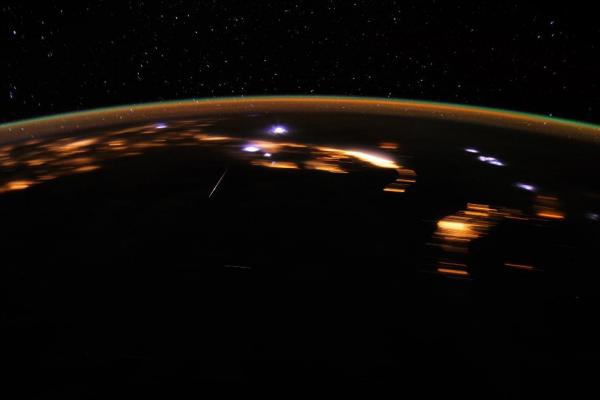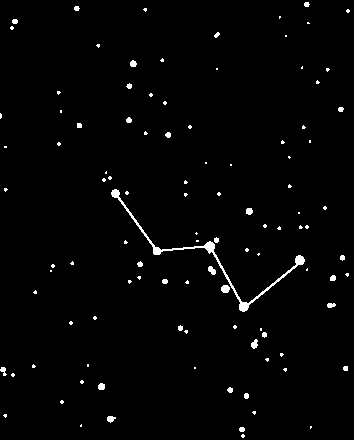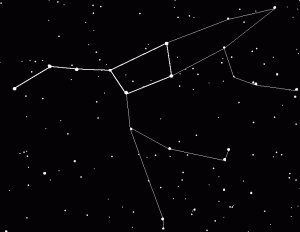Archive for the ‘Space Station’ Category
Lyrids Meteor Shower 2014
For the Lyrids Meteor Shower this year, the Moon is going to keep the sky quite light, which will make it much harder to see them. Saying that, it should still be possible, especially when they are at their peak on the 23rd April. I say this as I happened to be outside this past Tuesday night, watching the ISS fly over Plymouth, and to my surprise, whilst it was moving through Ursa Major (specifically the Plough part of the constellation), there were 5 or 6 tiny little explosions going off in the sky nearby. I couldn’t quite believe it really and it put me off watching the ISS (which I always find fascinating!).
I watched for several more minutes and saw several other meteors in the sky, in the general area of the sky off to the left of Ursa Major. These were not massive meteors as far as I could tell, as you only saw them for a split second, but this was probably due to the almost full moon which was keeping the sky bright and hiding all but the most brightest stars. These weren’t like the tiny explosions I saw during the ISS flyover, but more meteor like. I can only presume these were the Lyrids and the first batch I saw were so small and didn’t ‘shoot across the sky’ but burnt up as soon as they hit the atmosphere of the Earth. The second batch must have been slightly bigger and lasted longer when hitting the atmosphere. Either way, it was great viewing!
The Lyrids Meteors emanate from the constellation Lyra (hence their name) and they are part of the comet Thatcher that takes about 415 years to orbit the Sun. The peak of the shower is usually around the 21st to the 24th of April but they can be seen for several days before and after, depending on how lucky you are! I guess I was very lucky the other night!
Enjoy the Lyrids Meteor Gazing!! 😉
Perseids 2013
Last night I spent about 40 minutes outside meteor spotting. Luckily it was the first night in ages that there was a mostly clear sky, apart from the occasional wispy clouds that passed overhead. It was good timing as last night was the peak of the Perseid Meteor shower of 2013 although you can still see meteors up until the 24th August when the Earth passes out of the meteor hot spot.
It took a while to spot anything but in the end I managed to see 8 meteors, 4 satellites, the International Space Station (ISS – which was a nice surprise!) and a strange looking triangle shaped Plane with weird flashing lights (aliens? 😉 ). The most interesting thing of all was that I also saw a bright flash in the sky and then it gradually faded away. I think it must have been a larger meteor hitting the atmosphere and exploding or something but it seemed to be heading in the wrong direction for the meteor shower, which made it more strange. It would be interesting to know if anyone else saw this last night? It must have been about 23:20 when I saw this. Please leave a comment on this post if you did see that last night as well!
As mentioned above, if you missed the meteor show last night, then you can still see them up until near the end of the month. If you can find the constellations of Cassiopeia and The Plough (Ursa Major), then kind of look between and above them and this is the general area where the meteors shoot across the sky. There were some really good ones and a couple of years ago I saw the best meteor I have ever seen towards the end of August, so it is definitely possible to see them for a few weeks yet!
Lyrid Meteor Shower 2013
Unfortunately, this year the viewing of the Lyrid meteor shower will be hindered by a very bright and almost full Moon (if you get clear skies that is)! It’s a real shame as the Lyrid meteor shower is one of the best ones of the year. Having said that, if you are out on its peak, which is today (the 22nd April), you may still spot the brighter meteors, but obviously these will be far fewer than if it was a clear sky as you would see the fainter ones as well.
My wife and I went out last Friday evening (19th) to try and have a look as it was a very clear sky and the Moon wasn’t quite as bright as it would be tonight, and I managed to see one very faint meteor (I think) in the distance, but that was about it. We gave up on the meteors after about half an hour as it was still just too bright and the direction they come in is close to the horizon for us where a lot of trees are situated. If it clears up again tonight, I will go out and try and view them again (with my fingers crossed!).
One good thing that came out of viewing last Friday, was that I saw 2 satellites and also the International Space Station fly over (the first time for both this year due to the constant bad weather we have had!). I always enjoy viewing the ISS, even though you don’t really see much, as it still amazes me that that is a space station which we can see shining bright from Earth. I would be happy to view it every night if I could! 😉
Anyway, happy meteor spotting tonight and leave a comment on here or my twitter account (@strethewey) if you do manage to see anything!
Perseid Meteor Gazing
The weather forecast was not good for the actual height of the Perseid meteor shower (it turned out to be shocking) so I went out and had a look the day before, which was last Saturday. It turned out to be a strange half hour or so!
When I first went to look outside there was a massive flash of lightning which made me jump as I wasn’t expecting it, so I assumed that the sky would be completely cloudy, but I was surprised to see that the sky was in fact mostly clear. So I went on out and had a good stare at the sky above. During the star gaze, lightning was still flashing in the distance somewhere over Dartmoor, which made it interesting. In fact, the lightning turned a bit strange at one point as it seemed to be pulsing in one cloud only! It was like the scene in Independence Day when the alien ships first started to appear out of the skies around the world. The flashes were quick as well – no more than 10 to 15 seconds apart, so there must have been one heck of a storm over Dartmoor somewhere!
Luckily this weird lightning storm didn’t take anything away from the meteors as I saw some amazing ones shoot across the sky. On some, the ‘tail’ that they left was very distinct and easy to see well after the meteor itself had vanished! I think in the time I was out there (not much more than half an hour or so), I saw 6 or 7 meteors with probably 3 or 4 of those being really big and bright. Add to this, I saw the ISS again (purely by accident this time) and 6 other satellites, which meant it was a great time sky gazing! In fact, a couple of the meteors were up there with the best I have ever seen, although the one I saw in Weymouth last September was still the best ever as it was very bright and large as it streaked across the constellation of Cassiopeia.
Did anyone else manage to see any Meteors or the strange lighting storm? Send me a comment or tweet me (@strethewey) if you did!
ISS and Perseids 2012
Finally we have had a break in the miserable weather and I have been able to go out and have a look at the night Sky again!
Luckily the clearer night skies have coincided with the time of the year when the International Space Station is most visible in our region. Last night I saw it for the first time this year and it was as good as it was in 2011. This year it seems to have changed its trajectory in the sky as it came in from towards the Hoe and travelled towards Yelverton, wheras last year it came from the direction of Cornwall and right over the top of our house towards the edges of Dartmoor. I would recommend to anyone to have a look each evening for it. It is currently coming into view in Plymouth for several minutes between 21:30 and 23:00, but you will have to check for exact timings. Once you see it in the Sky, then you know what it is straight away as it is much brighter than anything else and it is moving at a constant speed. If you can get hold of some binoculars you should be able to see the solar panels on each side of the main pod with ease.
It is also the time of year for the annual Perseid Meteor Shower. This year the height of the shower is on the 12th and 13th of August. I am hoping the evenings will stay clear enough on those nights to view them, however I will be out before and after those dates as you will still be able to see the miniscule dust particles light up the night sky, but less frequently. They originate from the Perseus Constellation which is basically looking towards Dartmoor from anywhere in Plymouth, so can easily be seen.


